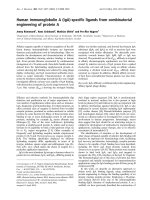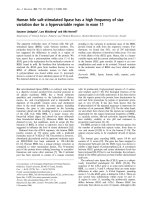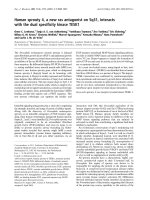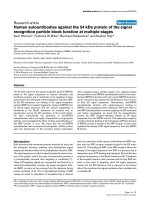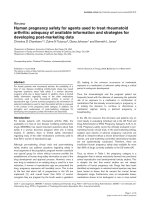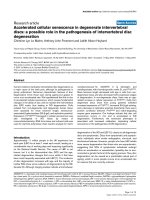Báo cáo y học: " Human cellular microRNA hsa-miR-29a interferes with viral nef protein expression and HIV-1 replication" ppsx
Bạn đang xem bản rút gọn của tài liệu. Xem và tải ngay bản đầy đủ của tài liệu tại đây (1.02 MB, 10 trang )
BioMed Central
Page 1 of 10
(page number not for citation purposes)
Retrovirology
Open Access
Research
Human cellular microRNA hsa-miR-29a interferes with viral nef
protein expression and HIV-1 replication
Jasmine K Ahluwalia
1
, Sohrab Zafar Khan
2
, Kartik Soni
1
, Pratima Rawat
2
,
Ankit Gupta
1
, Manoj Hariharan
1
, Vinod Scaria
1
, Mukesh Lalwani
1
,
Beena Pillai
1
, Debashis Mitra
2
and Samir K Brahmachari*
1
Address:
1
Institute of Genomics and Integrative Biology (IGIB) CSIR, Mall Road, Delhi-110007, India and
2
National Centre for Cell Science
(NCCS), University of Pune campus, Ganeshkhind, Pune-411007, Maharashtra, India
Email: Jasmine K Ahluwalia - ; Sohrab Zafar Khan - ; Kartik Soni - ;
Pratima Rawat - ; Ankit Gupta - ; Manoj Hariharan - ;
Vinod Scaria - ; Mukesh Lalwani - ; Beena Pillai - ;
Debashis Mitra - ; Samir K Brahmachari* -
* Corresponding author
Abstract
Background: Cellular miRNAs play an important role in the regulation of gene expression in
eukaryotes. Recently, miRNAs have also been shown to be able to target and inhibit viral gene
expression. Computational predictions revealed earlier that the HIV-1 genome includes regions
that may be potentially targeted by human miRNAs. Here we report the functionality of predicted
miR-29a target site in the HIV-1 nef gene.
Results: We find that the human miRNAs hsa-miR-29a and 29b are expressed in human peripheral
blood mononuclear cells. Expression of a luciferase reporter bearing the nef miR-29a target site
was decreased compared to the luciferase construct without the target site. Locked nucleic acid
modified anti-miRNAs targeted against hsa-miR-29a and 29b specifically reversed the inhibitory
effect mediated by cellular miRNAs on the target site. Ectopic expression of the miRNA results in
repression of the target Nef protein and reduction of virus levels.
Conclusion: Our results show that the cellular miRNA hsa-miR29a downregulates the expression
of Nef protein and interferes with HIV-1 replication.
Background
MicroRNAs (miRNAs) are naturally occurring small RNA
molecules that modulate gene expression by binding to
partially complementary target sites usually located in the
3'UTR of protein coding transcripts[1]. They have been
implicated in biological functions like tissue differentia-
tion, establishment of cell fate during development, apop-
tosis and oncogenesis [2-5]. The cellular miRNA, hsa-miR-
32 has been shown to directly interfere with the replica-
tion of primate foamy virus in HeLa cells and to reduce
viral RNA levels[6]. Another cellular miRNA, miR-122a,
involved in cellular stress response and modulated by
interferon beta, can also influence the susceptibility to
Hepatitis C virus [7-9]. Earlier, we had predicted sites in
the HIV-1 genome that can be potentially targeted by
human encoded miRNAs using consensus target predic-
Published: 23 December 2008
Retrovirology 2008, 5:117 doi:10.1186/1742-4690-5-117
Received: 25 June 2008
Accepted: 23 December 2008
This article is available from: />© 2008 Ahluwalia et al; licensee BioMed Central Ltd.
This is an Open Access article distributed under the terms of the Creative Commons Attribution License ( />),
which permits unrestricted use, distribution, and reproduction in any medium, provided the original work is properly cited.
Retrovirology 2008, 5:117 />Page 2 of 10
(page number not for citation purposes)
tion, and we had proposed the possibility that the cellular
levels of these miRNAs may determine disease progres-
sion following HIV-1 infection[10]. Here we experimen-
tally confirmed our computational predictions by
demonstrating that the expression of specific cellular miR-
NAs can reduce target protein expression and HIV-1 repli-
cation in cultured human cells.
We used a consensus approach to predict targets in the
HIV-1 genome for all human miRNAs. Five miRNAs (hsa-
miR-29a, 29b, 149, 324–5p and 378) that were prioritized
from the predictions by miRanda[11] and further refined
using RNAhybrid[12], MicroInspector[13], and DIANA-
MicroT[14], showed putative targets in four HIV-1 genes.
These included two miRNAs of highly related sequence
(hsa-miR-29a and hsa-miR-29b) that could potentially
bind to the region coding for the accessory protein, Nef of
HIV-1 (Fig. 1A). The predicted target site of hsa-miR-29a
and 29b, located 407 bases into the nef transcript, is
highly conserved in the sequences from all clades of HIV-
1 (A, B, C, D, F and H), with the exception of the outlier
group clade O (see Additional file 1). Previous studies
have shown that Nef is critical to the progression of HIV-
1 infection [15]. Nef is expressed early during the HIV-1
life cycle; and it represses CD4, promotes the release of
infectious HIV virions[16] and establishes a persistent
HIV-1 infection. The HIV-1 variant found in a cohort of
individuals who failed to show signs of disease manifesta-
tion even after 10 years of virus infection harbored a dele-
tion in nef. Nef deleted viruses thus fail to produce
symptoms of acquired immunodeficiency syndrome
(AIDS). This is consistent with recent studies that Nef is
necessary for efficient viral replication and pathogene-
sis[17]. As nef overlaps with the 3' long terminal repeat
(LTR), the inhibition of Nef may also lead to transcrip-
tional repression by interference of the 3'LTR func-
tion[18]. Furthermore, miRNA N367 which has been
shown to inhibit Nef has also been reported to downreg-
ulate the transcription and replication of HIV-1 [19]. The
importance of nef in HIV-1 infection prompted us to
experimentally test the anti-HIV-1 potential of hsa-miR-
29a and 29b.
Results and discussion
To address whether the appropriate miRNAs are expressed
in cells susceptible to HIV-1 infection, we first tested for
the presence of hsa-miR-29a and 29b in PBMCs isolated
from healthy volunteers. We also probed for hsa-miR-29c,
as this novel sequence-related miRNA has been added to
the hsa-miR-29 family since our original prediction (Fig.
1B). Hwang et al. have earlier reported that miR-29c could
not be detected in HeLa cells[20]. However, we detected
mature hsa-miR-29a, b and c in PBMCs, using primer
extension of species specific probes against 29a, b and c
(Fig. 1C, upper panel). To identify cells suitable for over-
expression of these miRNAs or their depletion using anti-
miRNA molecules, we determined the endogenous levels
of hsa-miR-29a, b and c in a variety of cell lines. The epi-
thelial derived HeLa cell line has been used widely for
reporter assays. We found that HeLa cells expressed 29 a,
b and c miRNAs (Fig. 1C, middle panel) at levels compa-
rable to PBMCs. HEK293T cells used extensively for HIV-
1 single cycle replication studies, on the other hand, did
not show detectable levels of miRNA (Fig. 1C, lower
panel). However, in later experiments we could observe
expression of hsa-miR-29a, b in HEK293T cells using
miRNA specific qRT-PCR Taqman assays. HEK293T cells,
therefore, appeared to be appropriate for artificially
expressing the miRNAs and for studying anti-HIV-1
potential in single cycle replication experiments. In addi-
tion, cell line specific miRNA expression profiling studies
have reported that 29 a, b and c are expressed in Jurkat
cells [21].
Reporter assays using the nef target region fused to the
3'UTR of luciferase gene in pMIR-REPORT™ Luciferase
(luc) were used next to test the suppressive ability of the
cellular miRNAs. The reporter-target fusion construct (luc-
nef) was co-transfected with a control beta-galactosidase
expression plasmid into HeLa cells which naturally
express hsa-miR-29a and 29b. Luciferase activity from the
reporter plasmid bearing the target region showed a three
fold reduction in expression (Fig. 2A) as compared to con-
trol luc-vector transfection. Luciferase RNA levels did not
show a significant reduction suggesting that the repres-
sion was post-transcriptional (Fig. 2B).
Locked nucleic acid (LNA)-modified anti-miRNA mole-
cules interfere with miRNA function in a highly specific
manner[22]. We used LNA-modified anti-miRNA oligo-
nucleotides against hsa-miR-29a and 29b (Fig. 2C) to
"knock-down" the cellular miRNAs. Such knock-down
should restore reporter activity from the luc-nef fusion
construct. Indeed, co-transfection of the luc-nef reporter
construct with LNA-modified anti-miR29a and b partially
restored the reporter activity in HeLa cells (Fig. 2D and
2E). LNA-modified anti-miR29a was the more effective of
the two, restoring reporter activity to 2.5 times that of
untreated controls. LNA-modified anti-miR29a and b had
no effect on the luciferase vector without the fused nef tar-
get sequence, supporting the specificity of the LNA-
miRNA interactions (Fig. 2D and 2E).
We next either over-expressed or down regulated hsa-miR-
29a and hsa-miR-29b to test the effects of these miRNAs
on virus replication. We cloned the pre-miRNA for hsa-
miR-29a and hsa-miR-29b into a mammalian expression
vector, pEGFP-N3. This construction was designed to
express the miRNA under the control of the CMV imme-
diate-early promoter, as a GFP-fusion transcript (Fig. 3A).
Retrovirology 2008, 5:117 />Page 3 of 10
(page number not for citation purposes)
Detection of hsa-miR-29a, b, c in different cell typesFigure 1
Detection of hsa-miR-29a, b, c in different cell types. (A) Schematic representation of the HIV-1 genome. Potential tar-
get sites complementary to hsa-miR-29a and b are marked with an arrow. (B) Schematic representation of the method of
detection and the oligonucleotides used to capture the miRNA(s). The oligonucleotides (blue) prime sequence specific exten-
sion (green) of each miRNA due to differences at the 3' end of the oligonucleotide-miRNA hybrid. The extension product is
radiolabeled by the introduction of alpha-P
32
-dCTP into the product at the positions underlined. The T tail of varying lengths at
the 5' end is used to improve the resolution of the products. (C) Expression of hsa-miR-29a, b, c in PBMC (upper panel), HeLa
(middle panel) and HEK293T (lower panel) cells. HEK293T cells show much lower expression level of hsa-miR-29a and b than
PBMCs or HeLa cells. (D) U6 RNA was detected using a similar approach to establish equal input of RNA. Product sizes
(nucleotides, nt) including length of T tails are indicated on the right. M: radiolabeled marker.
Retrovirology 2008, 5:117 />Page 4 of 10
(page number not for citation purposes)
Expression of the mature hsa-miR-29a and 29b was con-
firmed by quantitative real-time PCR (Fig. 3B). The
inserted pre-miRNA disrupted the 5' UTR region of the
EGFP reporter gene. In the absence of splice sites flanking
the pre-miRNA, the current model of miRNA process-
ing[23] predicts that miRNA processing would result in a
reduced expression of the downstream reporter gene.
Indeed, EGFP expression was drastically reduced in the
miRNA expressing clones (Fig 3C). We then used these
clones to over-express the miRNAs in HEK293T and Jurkat
cells transfected with either a Nef expression vector or an
HIV-1 molecular clone. In order to study the effect of the
miRNA expressed from the EGFP vectors, we co-trans-
fected pre-miRNA-EGFP fusion clones of hsa-miR-29a
and b, along with pCDNA-HA-Nef into HEK293T cells
and analyzed Nef expression by immunoblotting. As
shown in Fig. 4A, both the hsa-miR-29a and 29b express-
ing clones reduced the expression of Nef, with hsa-miR-
Nef target region downregulated reporter (luciferase) activity at a post-transcriptional level (A and B) while LNA modified anti-miRNA restored reporter activity (C, D and E)Figure 2
Nef target region downregulated reporter (luciferase) activity at a post-transcriptional level (A and B) while
LNA modified anti-miRNA restored reporter activity (C, D and E). (A) A construct containing the nef target region
cloned into the MCS (3'UTR) of pMIR-REPORT™ Luciferase vector was co-transfected into HeLa cells along with pMIR-
REPORT™ β-gal vector. After 24 h, luciferase activity was measured and normalized to beta-galactosidase levels. Relative Luci-
ferase activity was calculated with respect to cells transfected with pMIR-REPORT™ vector alone. Data represent mean ±
SEM of three independent experiments performed, each in triplicates. (B) Post-transcriptional regulation of Nef. Northern blot
using luciferase probe to show transcript levels of luciferase in luc and luc-nef transfected HeLa cells. β-actin was used as a
loading control (lower panel). (C) Design of LNA-modified anti-miRNA molecules for hsa-miR-29a and 29b. Red asterisks indi-
cate positions of LNA-modification in the backbone of the anti-miRNA molecule. (D and E) LNA-modified anti-miRNA against
hsa-miR-29a (D) and hsa-miR-29b (E) restored reporter activity from the luc-nef transfected cells. Varying concentrations (0
nM–40 nM) of LNA-modified anti-miRNA molecules were co-transfected with luc-nef clone and control pMIR-REPORT™ β-
gal vector into HeLa cells. Luciferase activity was measured after 24 hours and normalized to beta-galactosidase levels. Luci-
ferase activity relative to vector (luc) was plotted. Mean ± SEM from three replicate experiments are shown. LNA, locked
nucleic acid; luc, pMIR-REPORT™ vector; and luc-nef, nef target cloned in 3'UTR of pMIR-REPORT™.
Retrovirology 2008, 5:117 />Page 5 of 10
(page number not for citation purposes)
pEGFP-miRNA construct expressing hsa-mir-29a and 29bFigure 3
pEGFP-miRNA construct expressing hsa-mir-29a and 29b. (A) Diagrammatic representation of pEGFP-N3 vector con-
taining pre-miR29a and 29b. (B) Expression of hsa-mir-29a and 29b confirmed by quantitative real-time PCR. Data show the
expression levels of mir-29a and 29b from pEGFP-miR29a and 29b constructs compared to pEGFP-N3 vector. The data repre-
sent mean ± S.D. from two independent experiments in triplicates and have been normalized to mir-92 levels. (C) GFP expres-
sion from pEGFP-miRNA transfected HEK293T cells. Upper panel represents GFP (+)ve cells, while the lower panel shows
total number of cells transfected with pEGFP-N3 (left), pEGFP-miR29a (middle) and pEGFP-miR29b (right), under the 10×
objective of a NIKON florescent microscope.
Retrovirology 2008, 5:117 />Page 6 of 10
(page number not for citation purposes)
29a being highly active. This result indicates that hsa-miR-
29a and 29b inhibit Nef expression.
To analyze the effect of these miRNAs on virus replication,
we next co-transfected the miRNA-expressing clones with
HIV-1 molecular clone pNL4.3 into HEK293T cells. 48
hours post-transfection, the cells were lysed for analysis of
Nef expression, and the cell supernatant was used for HIV-
1 p24 antigen capture ELISA to quantitatively assess virus
production. Over-expression of hsa-miR-29a significantly
inhibited both Nef expression and virus production,
while modest inhibition was observed with hsa-miR-29b
(Fig. 4B, upper and lower panels). This data clearly show
that hsa-miR-29a inhibits Nef expression and viral repli-
hsa-mir-29a and b inhibited Nef expression and HIV-1 replicationFigure 4
hsa-mir-29a and b inhibited Nef expression and HIV-1 replication. (A) Nef expression was inhibited by hsa-miR-29a
and 29b. HEK293T cells were co-transfected with miRNA clones or control vector along with pCDNA-HA-Nef using calcium
phosphate precipitation. After 36 hours of transfection, cells were lysed and expression of Nef was analyzed by immunoblot-
ting using HA antibody. Immunoreactive actin bands were used as loading control. (B and C) hsa-miR-29a and hsa-miR-29b
miRNA clones inhibited virus production in HEK293T (B) and Jurkat cells (C). Cells were co-transfected with miRNA clones
or control vector along with HIV-1 molecular clone pNL4.3 (Materials and Methods). Cells were lysed post-transfection and
expression of Nef was analyzed by immunoblotting using Nef antibody (upper panels); culture supernatant was used for p24
antigen ELISA (lower panels). Asterisks in (B) represent significant p-value of 0.016 for inhibition mediated by 29a compared to
control. The difference observed with 29b is not significant. Asterisks in (C) represent significant p-value of 0.014 and 0.016 for
inhibition by 29a and 29b respectively, as compared to control vector.
Retrovirology 2008, 5:117 />Page 7 of 10
(page number not for citation purposes)
cation in HEK293T cells. As T cells are the primary target
of HIV-1, we then used human CD4+ T cell line, Jurkat, for
analyzing the role of hsa-miR-29a and 29b in virus repli-
cation. Jurkat cells were nucleofected with the miRNA-
expressing clones with the pNL4.3 viral clone and ana-
lyzed for Nef and p24 expression. In Jurkat T cells, both
hsa-miR-29a and 29b clones significantly inhibited Nef
expression (Fig. 4C, upper panel) and virus production
(Fig. 4C, lower panel). These results, taken together,
showed that the two human miRNAs not only inhibit Nef
expression but also virus replication.
In the over-expression studies, hsa-miR-29a consistently
showed higher efficacy in reducing viral replication and
Nef levels. To investigate the physiological role of cell
endogenous hsa-miR-29a on HIV-1 replication, we used
LNA modified anti-miR29a to downregulate cellular
miR29a in HEK293T cells. As shown in Figure 5A, the LNA
modified anti-miR29a resulted in a three fold reduction of
the cellular miR29a level. We observed a corresponding
increase in virus production, monitored using HIV-1 p24
antigen capture ELISA (Fig. 5B). We used a mock LNA-
modified oligonucleotide as a control to control for the
specificity of the anti-miR29a oligonucleotide. Anti-
miR29a transfected cells showed a two fold increase in
viral levels compared to the mock LNA control.
Although Nef was initially reported to be a negative factor
for HIV-1, later results from several laboratories including
ours [24,25] have found that Nef enhances HIV replica-
tion[17]. Interfering with Nef expression is expected to
decrease viral replication. Thus, the findings that the inhi-
bition of Nef by ectopic over expression of miR29a and
29b reduced viral replication and that the suppression of
endogenous miR29a by anti-miR29a LNA increased viral
replication are wholly consistent.
Conclusion
Accumulating evidence indicates that miRNAs of both
viral and host origin may influence host-virus interaction
in a variety of ways: as direct modulators of viral replica-
tion, as factors affecting viral susceptibility, and as indirect
modulators of cellular genes that influence viral propaga-
tion [26-29]. In this regard, artificial inhibition of the
miRNA processing machinery using siRNAs against Dicer
and Drosha has been shown to result in faster replication
of HIV-1 in PBMCs[30]. Dicer was also shown to be
important in cellular resistance to infection by Vesicular
Stomatitis Virus and influenza A virus since cells with
Dicer defective alleles or cells with knockdown of Dicer
exhibited hypersusceptibility to infection by these viruses
[31-33]. A recent report posited that different stages of
HIV-1 progression starting with infection followed by the
transition from latency to activated replication appears to
be associated with discrete expression profiles of cellular
miRNAs[34]. That study demonstrated a region common
to the 3'UTRs of all HIV-1 transcripts, except nef, which is
targeted by a cluster of five cellular miRNAs. These miR-
Cellular hsa-mir-29a inhibits HIV-1 replicationFigure 5
Cellular hsa-mir-29a inhibits HIV-1 replication. (A) LNA-modified anti-29a affected the levels of endogenous hsa-mir-
29a. LNA-modified anti-29a was co-transfected with pNL4.3 vector. Real time TaqMan microRNA quantification was per-
formed for miR29a. hsa-mir-92 was used as an endogenous control. (B) LNA-modified anti-29a increased HIV-1 replication rel-
ative to mock LNA. p24 antigen ELISA was carried out as described previously. Data represent mean ± SEM from two
independent experiments performed in triplicates.
Retrovirology 2008, 5:117 />Page 8 of 10
(page number not for citation purposes)
NAs were suggested to collectively aid in the establish-
ment of viral latency. Based on those observations, one
could reason that a panel of miRNA inhibitors might acti-
vate latent HIV-1 infection [34]. Compatible with such
reasoning, Wang et al. have indeed recently demonstrated
that the suppression of anti-HIV-1 miRNAs in monocytes
facilitates HIV-1 infectivity, while the increase in macro-
phages of miRNAs that target HIV-1 inhibited viral repli-
cation[35]. Our current results are consistent with the
emerging concept that augmenting the expression of cel-
lular anti-viral miRNAs can be a useful strategy in devel-
oping anti-HIV-1 therapeutics. In addition expression
levels of natural anti-HIV miRNAs may also be useful in
studying susceptibility to infection.
miRNAs are nodal molecules in an intricate network of
host-virus interactions that form a chain of strategies and
counter strategies developed by the virus and the host[26].
Taken together, the range of interactions between the HIV-
1 and host cells suggests that miRNAs may be involved in
fine tuning the transition from latency to activation, the
clearance of latent HIV-1 reservoirs, and the reduction of
virion production. Cellular miRNAs with anti-viral roles
may have additional roles in host cellular functions. Anti-
HIV-1 therapeutics based on the regulation of miRNA lev-
els will have to address how these changes perturb normal
cellular homeostasis.
Methods
Constructs
pEGFP-N3 (Clontech), pMIR-REPORT™ Luciferase
(Ambion) and pMIR-REPORT™ β-gal control plasmid
(Ambion) were commercially procured. pEGFP-N3-miR-
29a and -29b expressing constructs were prepared as fol-
lows: first, PCR amplification of fragments containing
pre-miRNA 29a (407 bp) and 29b (417 bp) was carried
out using the following primer pairs: 5'-ACAGGATATCG-
CATTGTTGG-3' and 5'-TATACCACATGCAATTCAG-3'
(for 29a) and 5'-CCCAGGCATGCTCTCCCATC-3' and 5'-
CATTTGTGATATATGCCACC-3' (for 29b). Next, pEGFP-
N3 vector was linearized using restriction enzyme SmaI.
Blunt-ends generated were modified by Taq polymerase
mediated addition of T overhangs and ligated to the PCR
fragments. Luc-nef was constructed as follows: 100 bp
sequence containing the nef target region was PCR ampli-
fied from the HIV-1 genome using primers (restriction site
underlined), 5'-CCGACTAGT
TTGGCAGAACTACACACC-
3' and 5'-CCCAAGCTT
GGCCTCTTCTACCTTATC-3',
restriction digested with SpeI and HindIII, and cloned
into corresponding sites in pMIR-REPORT. All clones
were confirmed by sequencing.
DNA oligonucleotides and LNA modified anti-miRNA
DNA oligonulceotides used for PCR amplification of pre-
miRNA and flanking regions, and primer extension based
detection of miRNAs were commercially procured (The
Centre for Genomic Application, India). Locked nucleic
acid-modified oligonucleotides were procured from Pro-
ligo.
Primer extension
Total RNA was isolated from PBMC, HeLa and HEK293T
cells using Trizol method (Invitrogen). 5 μg total RNA
from each sample was annealed to 10 pmol oligonucle-
otide designed to capture hsa-miR-29a, -b and -c, respec-
tively followed by extension using radiolabeled P
32
-dCTP
and M-MuLV Reverse Transcriptase at 37°C for 30 mins.
RNA was denatured and samples resolved on 18% Urea-
PAGE. Radioactive bands were detected on Fujifilm
FLA2000 phosphorimager. Sequence of the oligonucle-
otides used is given in Fig 1B, lower panel.
Northern blotting
10 μg of total RNA from luc and luc-nef tranfected HeLa
cells were resolved on 1.5% agarose gel and transferred
onto nylon membrane, followed by overnight hybridiza-
tion with radioactive probe of luciferase prepared as fol-
lows: 1.6 kb fragment generated by restriction digestion of
pMIR-REPORT™ Luciferase (Ambion) using BamHI and
XhoI and radiolabeled using NEBlot™ kit (NEB). β-actin
was used as a loading control. Radioactive bands were
detected using Typhoon TRIO imager, GE Healthcare.
Real time PCR
Real time quantification of miRNA expression was per-
formed using TaqMan probes specific for hsa-mir-29a and
29b employing the TaqMan microRNA assays kit (Applied
Biosystems) according to manufacturer's protocol. hsa-
mir-92 was used as an internal control.
Cell culture
HeLa, HEK293T and Jurkat cells were propagated in MEM,
DMEM and RPMI (Gibco) respectively, supplemented
with 10% FBS (Gibco), 1mM sodium pyruvate, 2 mM L-
glutamine and 1× Antibiotic (Sigma; broad-spectrum) in
5% CO
2
and humidified 37°C.
Transfection and Reporter assay
HeLa cells were co-transfected with pMIR-REPORT (luc or
luc-nef), pMIR-REPORT β-gal and varying concentrations
of LNA-modified anti-miR-29a or -29b using siPORT
NeoFX transfection agent (Ambion), according to the
manufacturer's protocol. 24 hrs after transfection, cells
were lysed in 1× RLB and assayed for luciferase and β-gal
activity using luciferase and β-gal assay system (Promega)
respectively, according to manufacturer's directions.
HEK293T cells were co-transfected with pcDNA-HA-Nef
and miRNA clones (pEGFP-N3-miR-29a or -29b) or con-
trol vector (pEGFP-N3) using calcium phosphate precipi-
tation. Cells were lysed 36 hrs post-transfection to
Retrovirology 2008, 5:117 />Page 9 of 10
(page number not for citation purposes)
proceed with immunoblot experiment using Nef anti-
body.
Single cycle replication studies
HEK293T were co-transfected with miRNA clones or con-
trol vector along with HIV-1 molecular clone pNL4.3
using Lipofectamine 2000. After 48 hrs of transfection,
culture supernatant was collected for p24 antigen ELISA
(Perkin Elmer Life Science, USA) and cells were lysed for
immunoblot experiment using Nef antibody. Similar
transfection and assay was also carried out in human
CD4+ Jurkat T cells using Amaxa nucleofection system.
Competing interests
The authors declare that they have no competing interests.
Authors' contributions
SKB, VS, MH designed the study. JA, SZK, KS, PR, AG per-
formed experiments. BP, DM analyzed the data and SKB,
BP, DM wrote the paper.
Additional material
Acknowledgements
The authors wish to acknowledge Souvik Maiti for assistance in designing
Locked Nucleic acid probes and Sridhar Sivasubbu and Ashok Patowary for
supporting experiments. The HIV-1 molecular clone pNL4.3 was obtained
from the NIH AIDS Reagent program, USA and the HA-Nef expression
vector was a kind gift of Prof. Warner Greene, USA. This work was sup-
ported by funding from Council for Scientific and Industrial Research. MH
was supported by a fellowship from Council for Scientific and Industrial
Research. The authors thank Director, NCCS for his encouragement and
support.
References
1. Pillai RS, Bhattacharyya SN, Filipowicz W: Repression of protein
synthesis by miRNAs: how many mechanisms? Trends Cell Biol
2007, 17:118-126.
2. Callis TE, Chen JF, Wang DZ: MicroRNAs in skeletal and cardiac
muscle development. DNA Cell Biol 2007, 26:219-225.
3. Fabbri M, Ivan M, Cimmino A, Negrini M, Calin GA: Regulatory
mechanisms of microRNAs involvement in cancer. Expert
Opin Biol Ther 2007, 7:1009-1019.
4. Kloosterman WP, Lagendijk AK, Ketting RF, Moulton JD, Plasterk
RH: Targeted inhibition of miRNA maturation with mor-
pholinos reveals a role for miR-375 in pancreatic islet devel-
opment. PLoS Biol 2007, 5:e203.
5. Makeyev EV, Zhang J, Carrasco MA, Maniatis T: The MicroRNA
miR-124 promotes neuronal differentiation by triggering
brain-specific alternative pre-mRNA splicing. Mol Cell 2007,
27:435-448.
6. Lecellier CH, Dunoyer P, Arar K, Lehmann-Che J, Eyquem S, Himber
C, Saïb A, Voinnet O: A cellular microRNA mediates antiviral
defense in human cells. Science 2005, 308:557-560.
7. Jopling CL, Yi M, Lancaster AM, Lemon SM, Sarnow P: Modulation
of hepatitis C virus RNA abundance by a liver-specific Micro-
RNA. Science 2005, 309:1577-1581.
8. Jopling CL, Norman KL, Sarnow P: Positive and negative modu-
lation of viral and cellular mRNAs by liver-specific micro-
RNA miR-122. Cold Spring Harb Symp Quant Biol 2006, 71:369-376.
9. Pedersen IM, Cheng G, Wieland S, Volinia S, Croce CM, Chisari FV,
David M: Interferon modulation of cellular microRNAs as an
antiviral mechanism. Nature 2007, 449:919-922.
10. Hariharan M, Scaria V, Pillai B, Brahmachari SK: Targets for human
encoded microRNAs in HIV genes. Biochem Biophys Res Commun
2005, 337:1214-1218.
11. John B, Enright AJ, Aravin A, Tuschl T, Sander C, Marks DS: Human
MicroRNA targets.
PLoS Biol 2004, 2:e363.
12. Kruger J, Rehmsmeier M: RNAhybrid: microRNA target predic-
tion easy, fast and flexible. Nucleic Acids Res 2006,
34:W451-W454.
13. Rusinov V, Baev V, Minkov IN, Tabler M: MicroInspector: a web
tool for detection of miRNA binding sites in an RNA
sequence. Nucleic Acids Res 2005, 33:W696-W700.
14. Kiriakidou M, Nelson PT, Kouranov A, Fitziev P, Bouyioukos C,
Mourelatos Z, Hatzigeorgiou A: A combined computational-
experimental approach predicts human microRNA targets.
Genes Dev 2004, 18:1165-1178.
15. Gorry PR, McPhee DA, Verity E, Dyer WB, Wesselingh SL, Learmont
J, Sullivan JS, Roche M, Zaunders JJ, Gabuzda D, Crowe SM, Mills J,
Lewin SR, Brew BJ, Cunningham AL, Churchill MJ: Pathogenicity
and immunogenicity of attenuated, nef-deleted HIV-1
strains in vivo. Retrovirology 2007, 4:66.
16. Ross TM, Oran AE, Cullen BR: Inhibition of HIV-1 progeny virion
release by cell-surface CD4 is relieved by expression of the
viral Nef protein. Curr Biol 1999, 9:613-621.
17. Joseph AM, Kumar M, Mitra D: Nef: "necessary and enforcing
factor" in HIV infection. Curr HIV Res 2005, 3:87-94.
18. Omoto S, Ito M, Tsutsumi Y, Ichikawa Y, Okuyama H, Brisibe EA, Sak-
sena NK, Fujii YR: HIV-1 nef suppression by virally encoded
microRNA. Retrovirology 2004, 1:44.
19. Omoto S, Fujii YR: Regulation of human immunodeficiency
virus 1 transcription by nef microRNA. J Gen Virol 2005,
86:751-755.
20. Hwang HW, Wentzel EA, Mendell JT: A hexanucleotide element
directs microRNA nuclear import. Science 2007, 315:97-100.
21. Takada S, Berezikov E, Yamashita Y, Lagos-Quintana M, Kloosterman
WP, Enomoto M, Hatanaka H, Fujiwara S, Watanabe H, Soda M, Choi
YL, Plasterk RH, Cuppen E, Mano H: Mouse microRNA profiles
determined with a new and sensitive cloning method. Nucleic
Acids Res 2006, 34:e115.
22. Kaur H, Babu BR, Maiti S: Perspectives on chemistry and thera-
peutic applications of Locked Nucleic Acid (LNA). Chem Rev
2007, 107:4672-4697.
23. Kim YK, Kim VN: Processing of intronic microRNAs. EMBO J
2007, 26:775-783.
24. Joseph AM, Ladha JS, Mojamdar M, Mitra D: Human immunodefi-
ciency virus-1 Nef protein interacts with Tat and enhances
HIV-1 gene expression. FEBS Lett 2003, 548:37-42.
25. Kumar M, Mitra D: Heat shock protein 40 is necessary for
human immunodeficiency virus-1 Nef-mediated enhance-
ment of viral gene expression and replication. J Biol Chem
2005, 280:40041-40050.
26. Scaria V, Hariharan M, Maiti S, Pillai B, Brahmachari SK: Host-virus
interaction: a new role for microRNAs. Retrovirology 2006,
3(68):68.
27. Scaria V, Hariharan M, Pillai B, Maiti S, Brahmachari SK: Host-virus
genome interactions: macro roles for microRNAs. Cell Micro-
biol 2007.
28. Kumar A, Jeang KT: Insights into cellular microRNAs and
human immunodeficiency virus type 1 (HIV-1). J Cell Physiol
2008, 216:327-331.
29. Yeung ML, Benkirane M, Jeang KT: Small non-coding RNAs,
mammalian cells, and viruses: regulatory interactions? Retro-
virology 2007, 4:74.
30. Triboulet R, Mari B, Lin YL, Chable-Bessia C, Bennasser Y, Lebrigand
K, Cardinaud B, Maurin T, Barbry P, Baillat V, Reynes J, Corbeau P,
Additional file 1
Supplementary Figure 1. Tabulated details of target sites of human micro-
RNA 29a on HIV reference sequence and HIV clades.
Click here for file
[ />4690-5-117-S1.tiff]
Publish with BioMed Central and every
scientist can read your work free of charge
"BioMed Central will be the most significant development for
disseminating the results of biomedical research in our lifetime."
Sir Paul Nurse, Cancer Research UK
Your research papers will be:
available free of charge to the entire biomedical community
peer reviewed and published immediately upon acceptance
cited in PubMed and archived on PubMed Central
yours — you keep the copyright
Submit your manuscript here:
/>BioMedcentral
Retrovirology 2008, 5:117 />Page 10 of 10
(page number not for citation purposes)
Jeang KT, Benkirane M: Suppression of microRNA-silencing
pathway by HIV-1 during virus replication. Science 2007,
315:1579-1582.
31. Otsuka M, Jing Q, Georgel P, New L, Chen J, Mols J, Kang YJ, Jiang Z,
Du X, Cook R, Das SC, Pattnaik AK, Beutler B, Han J: Hypersuscep-
tibility to vesicular stomatitis virus infection in Dicer1-defi-
cient mice is due to impaired miR24 and miR93 expression.
Immunity 2007, 27:123-134.
32. Matskevich AA, Moelling K: Dicer is involved in protection
against influenza A virus infection. J Gen Virol 2007,
88:2627-2635.
33. de Vries W, Haasnoot J, Velden J van der, van Montfort T, Zorgdrager
F, Paxton W, Cornelissen M, van Kuppeveld F, de Haan P, Berkhout
B: Increased virus replication in mammalian cells by blocking
intracellular innate defense responses. Gene Ther 2008,
15:545-552.
34. Huang J, Wang F, Argyris E, Chen K, Liang Z, Tian H, Huang W,
Squires K, Verlinghieri G, Zhang H: Cellular microRNAs contrib-
ute to HIV-1 latency in resting primary CD4(+) T lym-
phocytes. Nat Med 2007, 13:1241-1247.
35. Wang X, Ye L, Hou W, Zhou Y, Wang YJ, Metzger DS, Ho WZ: Cel-
lular microRNA expression correlates with susceptibility of
monocytes/macrophages to HIV-1 infection. Blood 2008. Epub
ahead of print

